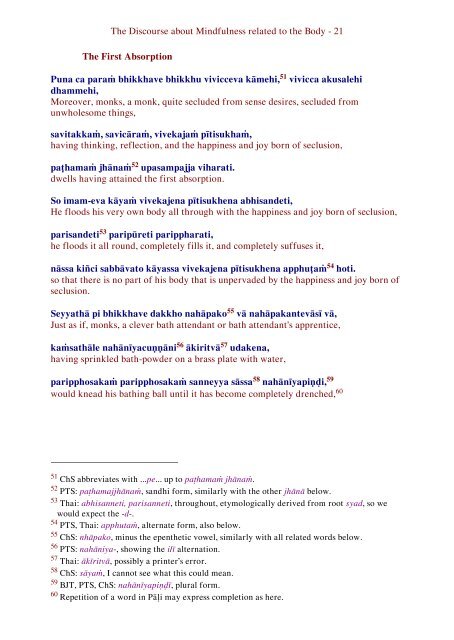Kayagatasatisuttam, the Discourse about Mindfulness related to the Body
A Pāli and English line by line (interlinear) version of this important discourse about the development of various meditations related to the body (together with extensive annotation).
A Pāli and English line by line (interlinear) version of this important discourse about the development of various meditations related to the body (together with extensive annotation).
Create successful ePaper yourself
Turn your PDF publications into a flip-book with our unique Google optimized e-Paper software.
The <strong>Discourse</strong> <strong>about</strong> <strong>Mindfulness</strong> <strong>related</strong> <strong>to</strong> <strong>the</strong> <strong>Body</strong> - 21<br />
The First Absorption<br />
Puna ca paraṁ bhikkhave bhikkhu vivicceva kāmehi, 51 vivicca akusalehi<br />
dhammehi,<br />
Moreover, monks, a monk, quite secluded from sense desires, secluded from<br />
unwholesome things,<br />
savitakkaṁ, savicāraṁ, vivekajaṁ pītisukhaṁ,<br />
having thinking, reflection, and <strong>the</strong> happiness and joy born of seclusion,<br />
paṭhamaṁ jhānaṁ 52 upasampajja viharati.<br />
dwells having attained <strong>the</strong> first absorption.<br />
So imam-eva kāyaṁ vivekajena pītisukhena abhisandeti,<br />
He floods his very own body all through with <strong>the</strong> happiness and joy born of seclusion,<br />
parisandeti 53 paripūreti parippharati,<br />
he floods it all round, completely fills it, and completely suffuses it,<br />
nāssa kiñci sabbāva<strong>to</strong> kāyassa vivekajena pītisukhena apphuṭaṁ 54 hoti.<br />
so that <strong>the</strong>re is no part of his body that is unpervaded by <strong>the</strong> happiness and joy born of<br />
seclusion.<br />
Seyyathā pi bhikkhave dakkho nahāpako 55 vā nahāpakantevāsī vā,<br />
Just as if, monks, a clever bath attendant or bath attendant’s apprentice,<br />
kaṁsathāle nahānīyacuṇṇāni 56 ākiritvā 57 udakena,<br />
having sprinkled bath-powder on a brass plate with water,<br />
paripphosakaṁ paripphosakaṁ sanneyya sāssa 58 nahānīyapiṇḍi, 59<br />
would knead his bathing ball until it has become completely drenched, 60<br />
51 ChS abbreviates with ...pe... up <strong>to</strong> paṭhamaṁ jhānaṁ.<br />
52 PTS: paṭhamajjhānaṁ, sandhi form, similarly with <strong>the</strong> o<strong>the</strong>r jhānā below.<br />
53 Thai: abhisanneti, parisanneti, throughout, etymologically derived from root syad, so we<br />
would expect <strong>the</strong> -d-.<br />
54 PTS, Thai: apphutaṁ, alternate form, also below.<br />
55 ChS: nhāpako, minus <strong>the</strong> epen<strong>the</strong>tic vowel, similarly with all <strong>related</strong> words below.<br />
56 PTS: nahāniya-, showing <strong>the</strong> i/ī alternation.<br />
57 Thai: ākīritvā, possibly a printer’s error.<br />
58 ChS: sāyaṁ, I cannot see what this could mean.<br />
59 BJT, PTS, ChS: nahānīyapiṇḍī, plural form.<br />
60 Repetition of a word in Pāḷi may express completion as here.

















